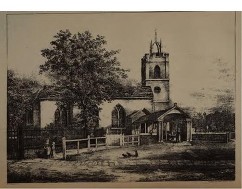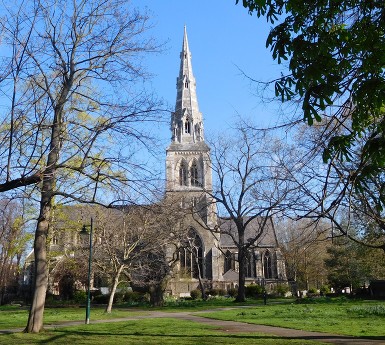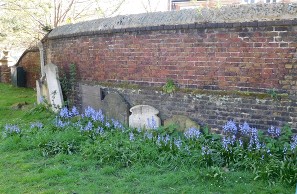





Exploring Southwark and discovering its history


St Giles Church, Camberwell
The Church of St Giles in Camberwell is a Victorian gothic church with an impressively tall spire. It stands within a large churchyard that was once the church’s graveyard. Though this church building is over 150 years old, there has been a church in this part of Camberwell for over 900 years and some say since the 7th century.



The Domesday Book was produced in 1085 during the reign of William I as an inventory of land in his newly acquired kingdom for the purposes of raising taxes. Camberwell, called Cambrewelle, was said to have 29 householders comprising 22 villagers and 7 smallholders. There was a church, land for five ploughs, 63 acres of meadow and woodland for 60 pigs. In 1152 a new church was built, or the existing one substantially altered. Some say parts of this church survived until the Victorian church was built but others that the old church only dated back to the reign of Henry VIII when the former church was either rebuilt to such a degree to completely change its original nature or a new church built on the same site. When the Victorian church was built, the foundations of two former structures were found.
The church is dedicated to St Giles, the patron saint of cripples. This is in keeping with how it is said Camberwell acquired it name which is said to derive from the natural wells occurring in the area reputed to heal the crippled, or the crooked. Camber was an old English word for crooked. The church was the focus of a busy parish, not then a part of London but a village with its own identity. The population grew and St George’s Camberwell was built in 1822 to accommodate the rise in population, the first of several additional churches to be built within the parish to serve the enlarged congregation.
The Old Church of St Giles was described as a neat Gothic structure of flint and roughstone and consisted of a chancel, nave and two aisles, with an embattled tower of about 80 feet at the west end. The windows were said to be beautifully adorned with painted glass. In the 19th century it was described as one of the most ancient churches in London.
Then late one Sunday night in February 1841 disaster struck when a fire broke out and took hold. Two patrolling policemen passing by spotted the fire in its early stages and raised the alarm which brought the vicar and the parish clerk to the church. The parish clerk reported that had there been some water close at hand the fire could easily have been put out at the early stages but there was no water to hand. The police station on Camberwell Green* sent messengers to various fire stations but before they had reached Walworth “the flames had broke forth into the horizon, and so brilliant was the reflection that it could be seen in all parts of London”. Fire engines arrived from all over London but by the time the first ones arrived the “flames had reached the tower, and were rushing from the belfry windows with an awful violence.” About 1 o’clock on Monday morning the roof fell in followed by the bells falling and an hour later the church had been destroyed. The cause of the fire was found to be the overheating of flues. The building was insured for £4,000 and no loss of life occurred.
Parish life went on and on that same Monday, while the fire was still smouldering, two marriages were conducted in the robing room which had remained untouched. Alternative accommodation was found for the holding of services.
The new church, that could accommodate a congregation of 1,500, was consecrated in November 1844. The Times described the church as a “very handsome building – perhaps the most appropriate and elegant building of the kind which has been raised in the neighbourhood of London for some years” It was built “in the style of the time of Edward II when the decorative manner began to be ingrafted on the plainer English Gothic of the earlier ages.“ The architects were George Gilbert Scott and W B Moffat, the former a major proponent of the Gothic revival who went on to design the Albert Memorial and Midland Grand Hotel, St Pancras Station. The Times correspondent was clearly very impressed by the new St Giles and ended his article on the church’s consecration by saying “there is nothing tawdry or theatrical in its appearance. It is a fitting place of worship for the inhabitants of a large and enlightened district.” The stained glass in the East Window was designed by local resident John Ruskin in collaboration with others and partly inspired by Chartres Cathedral.
Burials ceased in the churchyard in 1856. Despite being enlarged three times since the 18th century, the graveyard had become dangerously overcrowded and further burials were forbidden by Act of Parliament. Aware that the poorer parishioners were experiencing difficulty in burying their dead as they were unable to afford the private cemeteries (e.g. Nunhead Cemetery), the parish bought a plot of land near Forest Hill and Camberwell Old Cemetery was opened.
Mrs Basil Holmes reported in 1896 that the former graveyard attached to the church was not well kept and full of tombstones. The graves were not cleared until 1939 when the former graveyard was opened as a public garden. A few tombs and headstones remain today in the churchyard which is well kept and a peaceful public open space.
Web discoveries
- UK Casino Not On Gamstop
- UK Casino Not On Gamstop
- Non Gamstop Casino
- Casinos Not On Gamstop
- Non Gamstop Casinos
- Non Gamstop Casinos
- Non Gamstop Casino
- Casinos Not On Gamstop
- Casino Sites Not On Gamstop
- Slots Not On Gamstop
- Casinos Not On Gamstop
- UK Betting Sites Not On Gamstop
- UK Casino Not On Gamstop
- Best Non Gamstop Casinos
- Betting Sites
- Non Gamstop Casino Sites UK
- Best Non Gamstop Casinos
- Non Gamstop Casino
- Casinos Not On Gamstop
- Non Gamstop Casino Sites UK
- Horse Racing Betting